-
The synthesis of superheavy nuclei has always been an important task and challenge in nuclear physics, which is significant to expand the nuclear map, investigate the origin of heavy elements, and test the shell model. At present, the research on the synthesis of superheavy nuclei can be divided into two directions. One is to synthesize new elements to explore the charge limit of superheavy nuclei[1−3]. The other is to move towards to the double magic nuclei 298Fl, which is the center of the island of stability[4−7]. Because the β stability line bends towards the neutron axis, the currently produced superheavy nuclei based on fusion-evaporation reactions are neutron-deficient, and very far away from the island of stability. That requires us to strive towards the development of radioactive beam facilities and the search for new production mechanisms.
Several models have been developed to study the fusion mechanism and predict the production cross-sections of superheavy nuclei. The semi-classical models, such as the multidimensional Langevin-type dynamical equations[8], the nuclear collectivization model[9], the fusion-by-diffusion model[10] and the dinuclear system (DNS) model[11−13], have been successfully applied to calculate the evaporation-residue (ER) cross sections of superheavy nuclei. The microscopic models like time-dependent hartree-fock (TDHF) approach[14−15] and improved quantum molecular dynamics (ImQMD) model[16−17] can effectively describe the dynamical dissipation during the fusion process.
In this work, we attempted to produce superheavy nuclei in proton evaporation channels. To this end, we have developed the de-excitation part in the DNS model and found the production of Fl isotopes in proton evaporation channels is considerable.
-
Within the framework of DNS, the ER cross sections of superheavy nuclei at the incident energy $ E_{\rm{c.m.}} $ are calculated by[18]
$$ \begin{split} {\sigma_{\rm{ER}}(E_{\rm{c.m.}})}= &{\frac{{\rm{\pi}} \hbar^2}{2\mu E_{\rm{c.m.}}} \sum\limits_{J=0}^{J_{\rm{max}}}(2J+1)T(E_{\rm{c.m.}},J)}\times \\ &{ P_{\rm{CN}}(E_{\rm{c.m.}},J)W_{\rm{sur}}(E_{\rm{c.m.}},J).} \end{split} $$ (1) Here, $ T $, $ P_{\rm{CN}} $, and $ W_{\rm{sur}} $ are the transmission, fusion, and survival probability, respectively.
It is difficult to obtain an analytical expression for the transmission probability due to the complexity of the actual Coulomb barrier, and it can be obtained by using the WKB method after making a parabolic approximation of the Coulomb barrier[19]:
$$ \begin{split} &T(E_{\rm{c.m.}},J)= \int f(B) \times \\ &\dfrac{1}{1+\exp \left\{{-\dfrac{2\rm{\pi}}{\hbar\omega(J)}\left[E_{\rm{c.m.}}-B-\dfrac{\hbar^2}{2\mu R_{\rm{B}}^2(J)}J(J+1)\right]} \right\}}{\rm{d}}B . \end{split} $$ (2) Here, $ \hbar\omega $ is the width of the parabolic barrier and $ R_{\rm{B}} $ defines the position of the barrier. Considering the multi-dimensional character of the realistic barrier, the barrier distribution function $ f(B) $ should be introduced, which is taken as the asymmetric Gaussian form[9].
The interaction potential after considering deformation can be written as
$$ \begin{split} V(R,\beta_1,\beta_2,\theta_1,\theta_2)= & V_{\rm{C}}(R,\beta_1,\beta_2,\theta_1,\theta_2)+ V_ {\rm{N}}\left(R,\beta_1,\beta_2,\theta_1,\theta_2\right) + \\ & \dfrac{1}{2} C_1\left(\beta_1-\beta_1^0\right)^2 +\dfrac{1}{2} C_2\left(\beta_2-\beta_2^0\right)^2, \\[-13pt] \end{split} $$ (3) where $ V_{\rm{C}} $ and $ V_ {\rm{N}} $ are Coulomb potential and nuclear potential, given by Wong's formula and double folding method, respectively. $\beta_{1,\;2}^0$ is the static deformation (for nuclei 1 and 2), usually taken as the quadrupole deformation. $\beta_{1,\;2}$ is the dynamical deformation. Assuming that the deformation energy is proportional to the mass number, i.e. $C_1\beta_1^2/C_2\beta_2^2 = A_1/A_2$, only one deformation parameter $\beta = \beta_1+\beta_2$ can be used to represent the dynamical deformation. $C_{1,\;2}$ are the coefficients that characterize nuclear hardness and given by
$$ C=(\lambda -1)\left [(\lambda +2)R_ {\rm{N}}^2\sigma -\frac{3}{2\rm{\pi} } \frac{Z^2e^2}{R_ {\rm{N}}(2\lambda +1)} \right ]. $$ (4) Here, $ R_ {\rm{N}} $ is the nuclear radius, $ \lambda $ is the deformation number, taking 2 for quadrupole deformation. $ \sigma $ is the surface tension coefficient and given by $4{\rm{\pi}} R^2\sigma=a_ {\rm{s}}A^{2/3}$, where $ a_ {\rm{s}} $ is taken as 18.32 MeV.
The distribution probability $ P(Z_1,N_1,t) $ for the fragment ($ Z_1 $,$ N_1 $) at time $ t $ is determined by solving the master equation[20] :
$$ \begin{split} \frac{{\rm{d}}P(Z_1,N_1,t)}{{\rm{d}}t}& =\sum\limits_{Z_1'} W_{Z_1,\;N_1;\;Z_1',\;N_1}(t)\big[d_{Z_1,\;N_1}P(Z_1',N_1,t)- \\ & d_{Z_1',\;N_1}P(Z_1,N_1,t)\big] + \\ &\sum\limits_{N_1'} W_{Z_1,\;N_1;\;Z_1,\;N_1'}(t)\big[d_{Z_1,\;N_1}P(Z_1,N_1',t) - \\ & d_{Z_1,\;N_1'}P(Z_1,N_1,t)\big] - \\ &{[\varLambda _{\rm{qf}}(\varTheta (t))+\varLambda _{\rm{fis}}(\varTheta (t))]P(Z_1,N_1,t).} \end{split} $$ (5) Here, $d_{Z_1,\;N_1}$ discribes the microscopic dimension corresponding to the macroscopic state $ (Z_1,N_1) $. $ \varLambda _{\rm{qf}} $ and $ \varLambda _{\rm{fis}} $ are the quasifission and fission rates, calculated by the one-dimensional Kramers equation[21]. $ \varTheta (t) = \sqrt{\varepsilon ^*/a} $ is the local temperature, obtained from the Fermi gas model, where $ \varepsilon ^* $ is the local excitation energy of the dinuclear system, and $ a $ is the level density parameter. $W_{Z_1,\;N_1;\;Z_1',\;N_1} (W_{Z_1,\;N_1;\;Z_1,\;N_1'})$ is the transition probability from state $ (Z_1,N_1) $ to $ (Z_1',N_1) $ (or from $ (Z_1,N_1) $ to $ (Z_1,N_1') $), which can be written as:
$$ \begin{split} W_{Z_1,\;N_1;\;Z_1',\;N_1}(t)= & \dfrac{\tau_{\rm{mem}}\left(Z_1,N_1,E_1,Z_1',N_1,E_1';t\right)}{\hbar^2d_{Z_1,\;N_1}d_{Z_1',\;N_1}}\times \\ &\displaystyle\sum\limits_{ii'}\left|\left\langle Z_1',N_1,E_1',i'|V(t)|Z_1,N_1,E_1,i \right\rangle \right|^{2}.\end{split} $$ (6) Here, $ i $ represents the remaining quantum numbers. $ E_1 $ denotes the local excitation energy. $ \tau_{\rm{mem}} $ is the memory time and given by[11]
$$ \tau_{\rm{mem}}\left(A_1,E_1,A'_1,E'_1,t\right) = \hbar \sqrt{\frac{2 \rm{\pi}}{\displaystyle\sum\limits_{KK'} \left\langle V_{KK'}V_{KK'}^{*}\right\rangle}}. $$ (7) The compound nucleus formed by fusion reaction has high excitation energy and deexcites by emission of γ-rays, light particles and fission. According to Weisskopf's evaporation theory[22], the evaporation width of particle $ \nu $ can be written as:
$$ \begin{split} &\varGamma_{\nu}(E^{*},J) = (2s_{\nu}+1)\frac{m_{\nu}}{\rm{\pi}^2\hbar^2\rho(E^{*},J)} \times \\ &\qquad{ \int \limits _{0}\limits ^{E^{*}-B_{\nu}-\delta-\delta_ {\rm{{n}}}-\tfrac{1}{a}} \varepsilon\rho(E^{*}-B_{\nu}-\delta_ {\rm{{n}}}-\varepsilon)\sigma_{\rm{inv}}(\varepsilon){\rm{d}}\varepsilon,} \end{split}$$ (8) where $ B_{\nu} $, $ m_{\nu} $, and $ s_{\nu} $ are the binding energy, mass, and spin of the particle, respectively. The pairing correction $ \delta $ is set to be $ 12/\sqrt{A} $, 0, and $ -12/\sqrt{A} $ for even-even, odd-A, and odd-odd nuclei, respectively. $ \delta_ {\rm{n}} $ is the neutron correction energy. If the neutron number of the compound nucleus is odd, $ \delta_ {\rm{n}} = 12/\sqrt{A} $, and $ \delta_ {\rm{n}} = 0 $ in other cases. $ \rho $ is the energy level density and calculated by the Fermi-gas model. The level density parameter $ a $ is given by
$$ a(E^*,Z,N) = \tilde{a}(A)[1+E_{\rm{sh}}(Z,N)f(E^*-\varDelta)/(E^*-\varDelta)], $$ (9) Here, asymptotic Fermi-gas value of the level density parameter $ \tilde{a}(A)=\alpha A +\beta A^{2/3} b_ {\rm{s}} $. $ E_{\rm{sh}}(Z,N) $ is the shell correction energy, and $ f(E^*) $ is the shell damping factor. The parameters $ \alpha $, $ \beta $ and $ b_ {\rm{s}} $ are taken to be 0.114, 0.098 and 1.0, respectively. The inverse cross section $ \sigma_{\rm{inv}} $ is given by the following formula :
$$ \sigma_{\rm{inv}}(\varepsilon)= \left\{\begin{array}{*{20}{ll}} \rm{\pi} {R_{\nu}^2\left(1-\dfrac{V_{\nu}}{\varepsilon}\right),} &{\varepsilon > V_{\nu}} \\ {0 ,}&{\varepsilon < V_{\nu} }\end{array}\right. $$ (10) where $ R_{\nu} $ can be expressed as:
$$ R_{\nu} = 1.16\left[(A-A_{\nu})^{1/3}+A_{\nu}^{1/3}\right]. $$ (11) Here, $ A_{\nu} $ is the mass number of the evaporated particle. For proton evaporation, the Coulomb barrier $ V_{\nu} $ is parameterized by the following formula :
$$ V_{\nu} = [1.15Z_{\nu}(Z-Z_{\nu})]/(R_{\nu}+1.6). $$ (12) The survival probability of a superheavy nucleus can be expressed as[22]:
$$ \begin{split} & W_{\rm{sur}}(E^*_{\rm{CN}},x,y,J) = P(E^*_{\rm{CN}},x,y,J) \times \\ &\qquad \displaystyle\prod\limits_{i=1}^x\dfrac{\varGamma_{\rm{p}}(E^*_{i},J)}{\varGamma_{\rm{tot}}(E^*_{i},J)}\displaystyle\prod\limits_{j=x+1}^{x+y}\dfrac{\varGamma_{ {\rm{n}}}(E^*_{j},J)}{\varGamma_{\rm{tot}}(E^*_{j},J)} , \end{split} $$ (13) where $\varGamma_{\rm{tot}} = \varGamma_{ {\rm{n}}}+\varGamma_{\rm{p}}+\varGamma_{\rm{f}}$. The fission width $ \varGamma_{\rm{f}} $ is given by the Bohr Wheeler formula,
$$ \begin{split} & {\varGamma _{\rm{f}}(E^*,J) = }{\frac{1}{2\rm{\pi} \rho _{\rm{f}}(E^*,J)}\times } \\ &\qquad {\int\limits_{0}^{E^*-b_{\rm{f}}-\delta -\tfrac{1}{a_{\rm{f}}}}\frac{\rho _{\rm{f}}(E^*-b_{\rm{f}}-\varepsilon,J) {\rm{d}}\varepsilon }{1+ {\rm{exp}}[-2 \pi (E^*-b_{\rm{f}}-\varepsilon)/\hbar \omega ]}.}\end{split}$$ (14) Here, $ P(E^*_{\rm{CN}},x,y,J) $ is the realization probability, which is given by the Jackson formula[23]. $ E^*_{i} $ is the excitation energy before evaporating the $ i $-th particle. $ B_{i}^{\nu} $ is the separation energy of the i-th particle. $ T_{i} $ is nuclear temperature before the $ i $-th particle evaporated, obtained from $T_{i} = \sqrt{E^*_{i}/a}$.
-
Firstly, in order to find the compound nuclei with the largest cross section in the proton evaporation channel, we defined a ratio $ B_{\rm{f}}/B_{\rm{p}} $ to evaluate the strength of proton evaporation of the compound nuclei, here $ B_ {\rm{f}} $ is the fission barrier and $ B_ {\rm{p}} $ is the proton separation energy. Fig. 1 shows the calculated ratios $ B_{\rm{f}}/B_{\rm{p}} $ of nuclei 286−297Nh, 286−297Fl, 285−296Mc, and 286−297Lv which denoted by the circles, squares, triangles, and pentagrams, respectively. It can be seen that the ratios $ B_{\rm{f}}/B_{\rm{p}} $ of 285−296Mc are the highest and the fission barrier is approximately 2-4 times the proton separation energy, which means that proton evaporation is easier for 285−296Mc during the de-excitation process, resulting in a larger proton evaporation probability. The ratios $ B_{\rm{f}}/B_{\rm{p}} $ of 286−297Fl are the smallest, which means that 286-297Fl is hard to evaporate protons due to the proton closed-shell at Z = 114. From that, one can first synthesize compound nuclei with Z = 115, and then obtain the Fl isotopes by evaporating one proton and $ n $ neutrons.
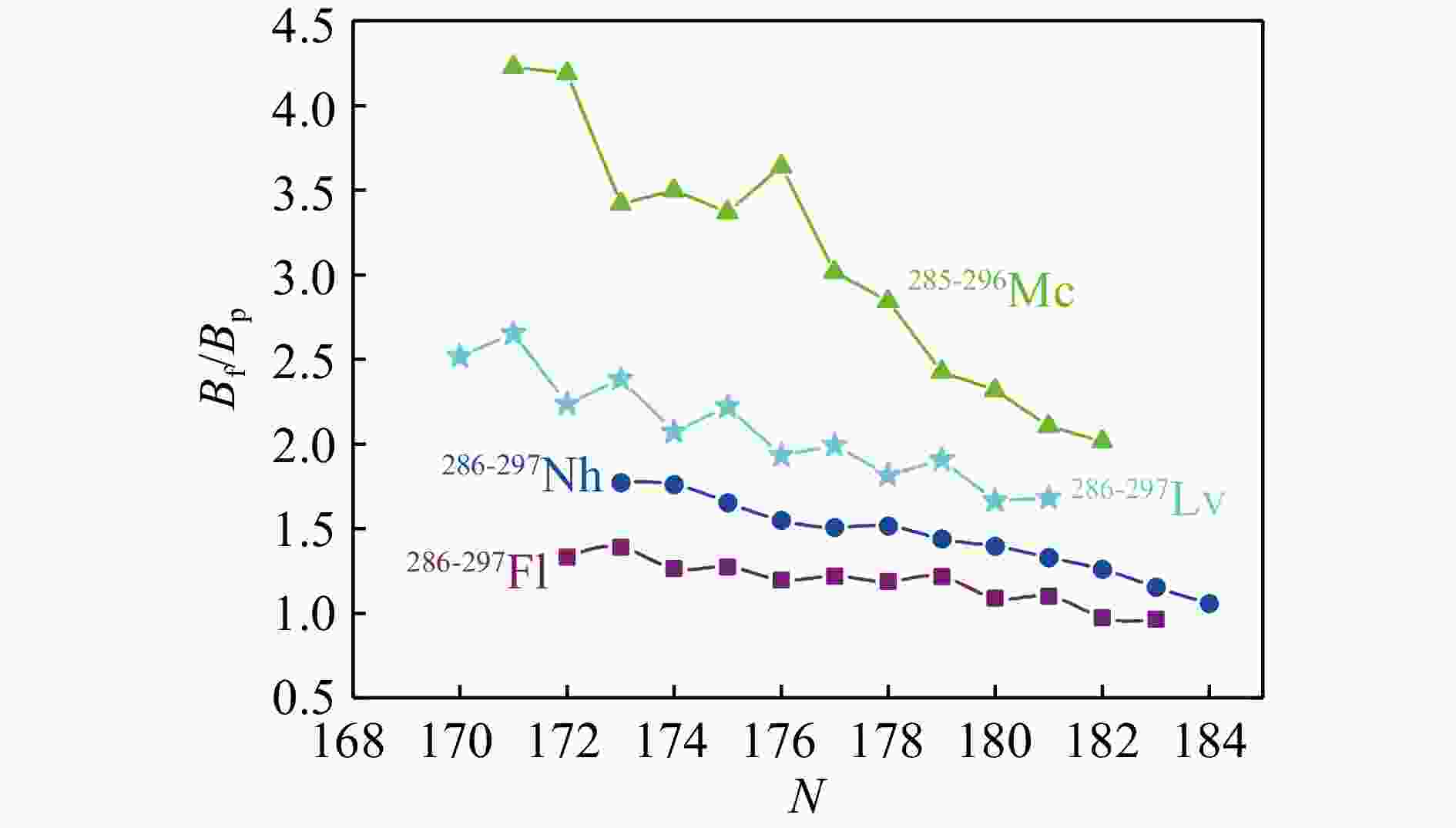
Figure 1. The ratios $ B_{\rm{f}}/B_{\rm{p}} $ of nuclei ${\rm{Nh}}^{286-297}$, $ {\rm{Fl}}^{286-297} $, $ {\rm{Mc}}^{285-296} $, and $ {\rm{Lv}}^{286-297 } $ are denoted by the circles, squares, triangles, and pentagrams, respectively. (color online)
To verify the reliability of the DNS model, we calculated the ER cross sections in 40Ar+179Hf reactions as shown in Fig. 2. The p2n, p3n, and p4n evaporation channels are denoted by solid, dashed, and dash-dotted lines, respectively. The experimental data in p2n, p3n, and p4n evaporation channels are represented by circles, squares, and triangles, respectively[24]. It can be seen that the calculated results are in good agreements with the experimental data, but at low incident energy the calculated results are significantly lower than the experimental data. This is because in the de-excitation process, the evaporation of charged particles is based on classical considerations and the quantum tunneling effect is not consider.
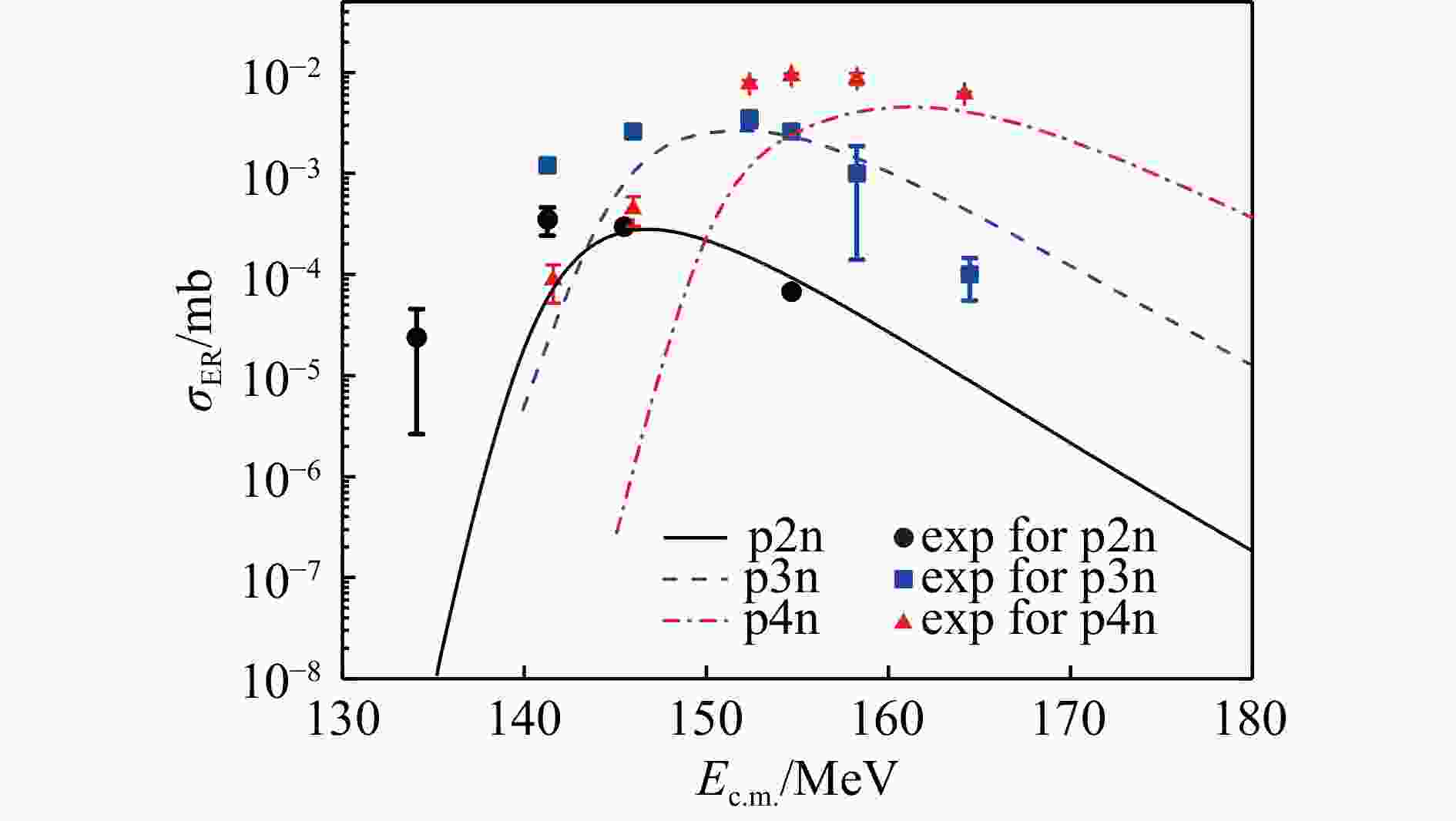
Figure 2. Comparisons of calculated evaporation residual cross sections with the experimental data in 40Ar+179Hf reactions. The solid, dashed, and dash-dotted lines represent the calculated evaporation residual cross sections in p2n, p3n, and p4n evaporation channels respectively. The circles, squares, and triangles represent the experimental data with error bars in p2n, p3n, and p4n evaporation channels, respectively. The experimental data are obtained from Ref. [24]. (color online)
In order to produce superheavy nuclei in proton evaporation channel, firstly it is necessary to consider the number and order of the evaporated protons. Therefore, in Fig. 3, we calculated the evaporation width of 48Ca+243Am reaction in which the Mc compound nuclei can be produced. It can be seen that the proton evaporation width is the smallest. Compared to neutron evaporation width, the survival probability decreases by 1-2 orders of magnitude after each proton evaporated. Therefore, in this work, we only considered the case of evaporating one proton, and the survival probability of multiple protons evaporated is too small, which can be ignored. Secondly, as the excitation energy decreases, the proton evaporation width decreases very quickly, and the ratio $ \varGamma_ {\rm{p}}/\varGamma_ {\rm{n}} $ decreases. The survival probability will be reduced by 1-2 orders of magnitude after each proton evaporated. In the end, we only consider the case where one proton is evaporated firstly and then $ n $ neutrons are evaporated, and the survival probability in other cases is ignored.
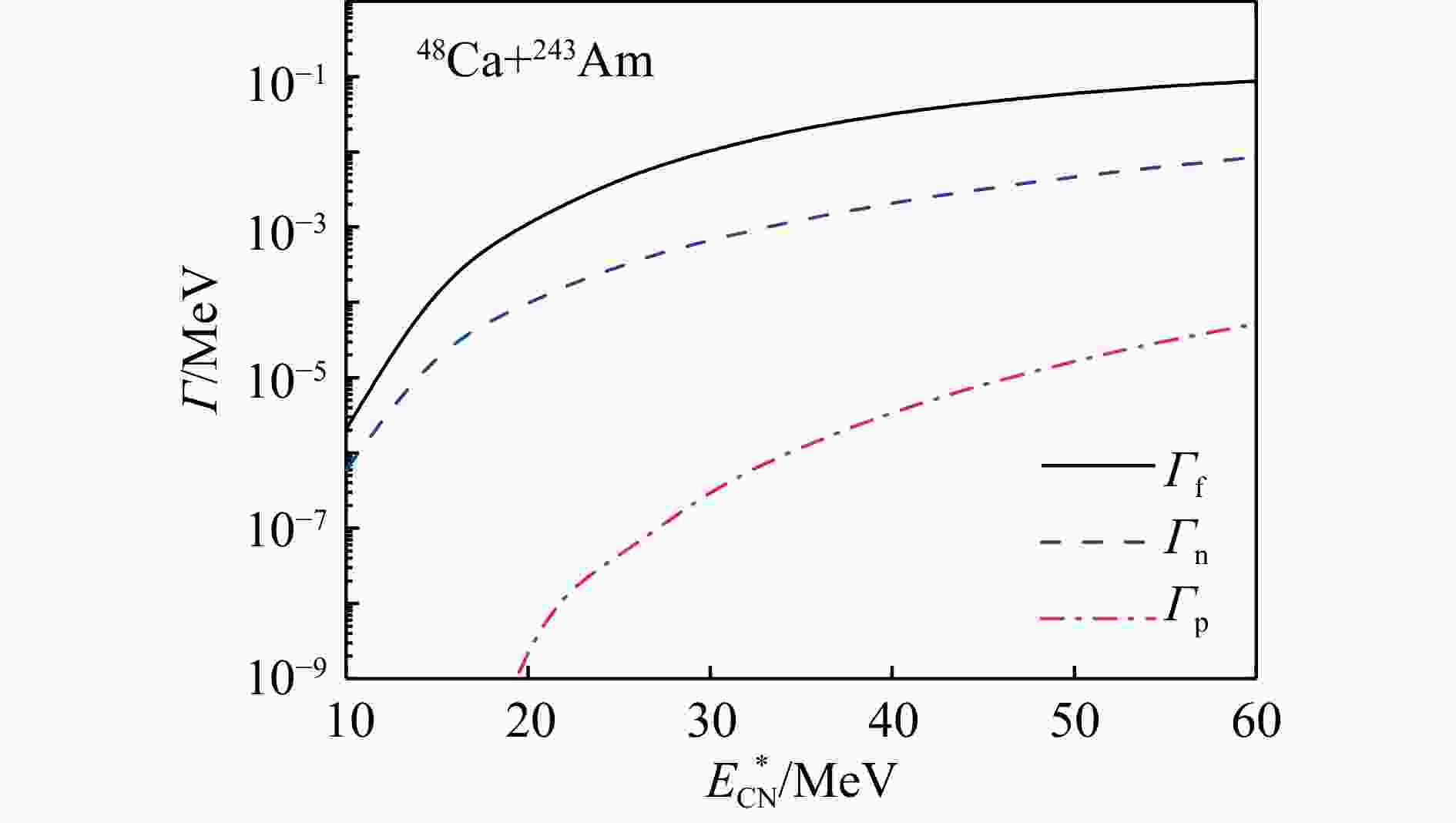
Figure 3. The calculated evaporation width of compound nucleus 291Mc produced by 48Ca+243Am reaction. The solid, dashed, and dash-dotted lines represent the widths of fission, neutron, and proton, respectively. (color online)
The ER cross sections in 38S+255Es, 50Ti+243Np, 54Cr+239Pa, and 42S+254Es reactions for producing Fl isotopes are shown in Fig. 4. Solid, dashed, dash-dotted, and dotted lines represent p1n, p2n, p3n, and p4n evaporation channels, respectively. For these reactions, the ER cross sections in p2n and p3n channels are relatively larger. One can find that the ER cross sections in the reaction 38S+255Es are the highest among the previous three reactions corresponding to the same compound nucleus. That is because the mass asymmetry for the 38S+255Es reaction is the largest, leading to the highest fusion probability. The maximum ER cross sections of unknown isotopes 290, 291Fl are 1.1 pb and 15.1 pb at $ E_{\rm{CN}}^{*} = 38.2 $ MeV and 39.4 MeV, respectively. 38S beam can be produced by the fragmentation of 40Ar at a projectile fragmentation facility[25], and the fusion reactions 38S+181Ta and 38S+208Pb with 38S beam were conducted successfully.
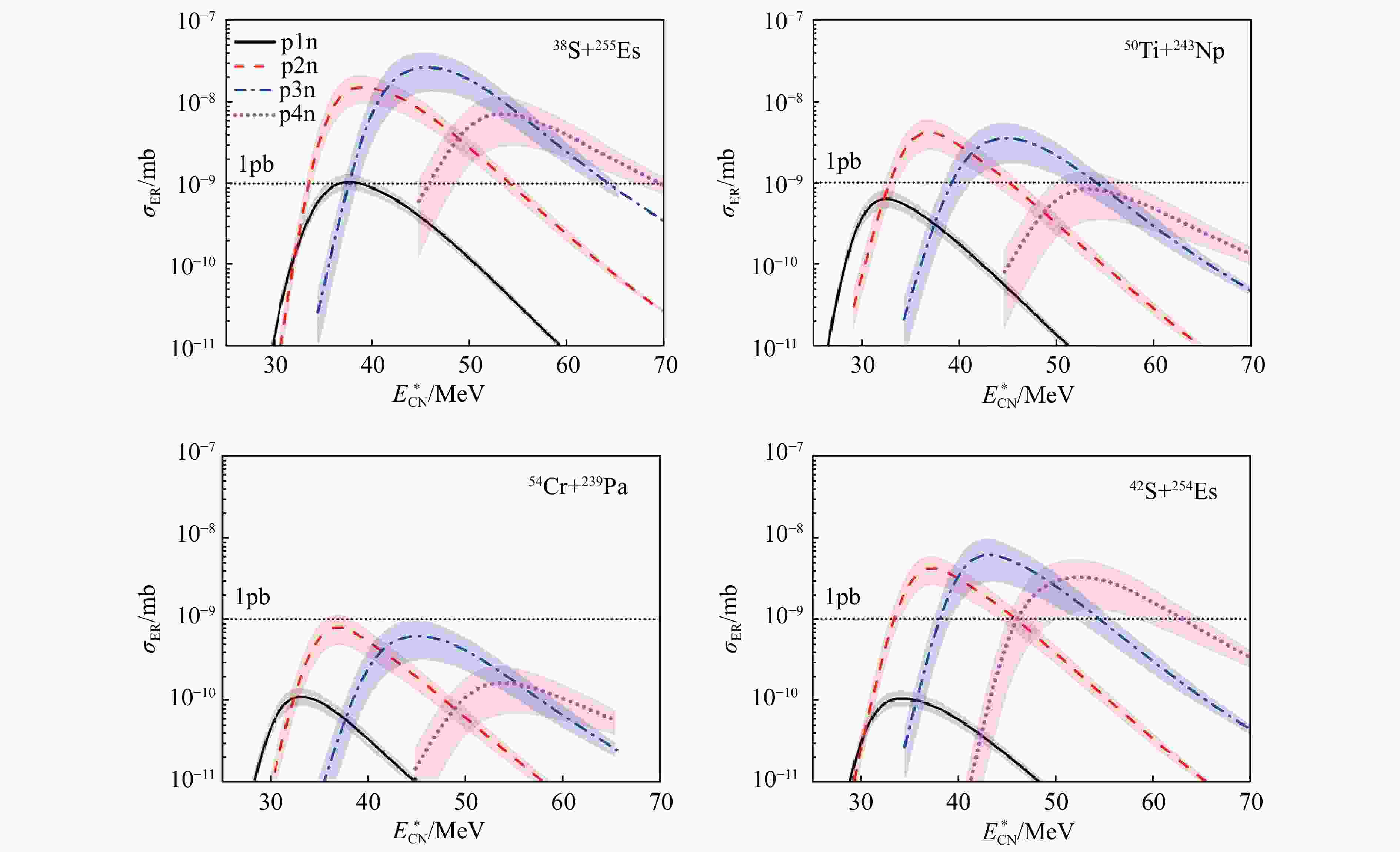
Figure 4. The calculated evaporation residual cross sections in 38S+255Es, 50Ti+243Np, 54Cr+239Pa, and 42S+254Es reactions. Solid, dashed, dash-dotted, and dotted lines represent p1n, p2n, p3n, and p4n evaporation channels, respectively. Shadow area represents the calculated error. (color online)
In order to produce more unknown Fl isotopes, the ER cross sections in the radioactive beam induced reaction, 42S+254Es, are also predicted. Four unknown isotopes, 291−294Fl, are synthesized with cross sections 3.2, 6.0, 4.0, and 0.1 pb at $ E_{\rm{CN}}^{*} = 42.2 $, 28.6, 20.2, and 15.0 MeV, respectively. One can notice that the ER cross sections in 42S+254Es reaction in p4n channel are comparable to those in p2n and p3n channels unlike the other three reactions. That is because the compound nucleus in the reaction 42S+254Es has more neutrons than the other three reactions, leading to the highest survival probability in p4n channel. If the radioactive beam facilities are upgraded and the intensity of the 42S beam is increased to a high quantity in the future, the reaction 42S+254Es can be a promising candidate to approach the island of stability.
Considering the sensitivity of the DNS model to certain parameters, it is necessary to evaluate the inaccuracy of theoretical calculations in order to find out the uncertainty of predictions. Among the parameters in the model, the shell damping factor $ E_{\rm{d}} $ plays a vital role in the ER cross sections[26]. The shell damping factor cannot be precisely determined both experimentally and theoretically, and its inaccuracy is considered based on the experimental data in the Ref.[27]. The uncertainty of the calculation results is shown in the shadow in Fig. 4. It can be seen that the uncertainties of the ER cross sections of Fl isotopes are no better than one order of magnitude, and the uncertainties of the optimal excitation energy are only in the order of 0.1 MeV.
-
In summary, the production of Fl isotopes in proton evaporation channels is investigated within the DNS model. Among the isotopes around $ Z = 114 $, proton evaporation is the easiest for Mc isotopes but the most difficult for Fl isotopes due to the proton closed-shell at $ Z = 114 $. Hence, one can synthesize the Fl isotopes in the proton evaporation channel. The calculated ER cross sections by the DNS model reproduce the experimental data very well. The synthesis of unknown isotopes 290,291Fl is studied via 38S+255Es, 50Ti+243Np, and 54Cr+239Pa reactions corresponding to the same compound nucleus. The ER cross sections of 290Fl and 291Fl in the reaction 38S+255Es are the largest, which are 1.1 pb and 15.1 pb at $ E_{\rm{CN}}^{*} = 38.2 $ MeV and 39.4 MeV, respectively. In the radioactive beam induced reaction 42S+254Es, four new isotopes 291−294Fl are synthesized with ER cross sections of 3.2, 6.0, 4.0, and 0.1 pb at $ E_{\rm{CN}}^{*} = 42.2 $, 28.6, 20.2, and 15.0 MeV, respectively. The uncertainties of the predictions from the inaccuracy of the shell damping factor are calculated, and the uncertainties of the ER cross sections of Fl isotopes are no better than one order of magnitude.
Acknowledgments This work was supported by the Guangxi Natural Science Foundation under Grant No. 2022GXNSFBA035549.
Exploring the Feasibility of Producing Superheavy Nuclei in the Proton Evaporation Channel
-
摘要: 在双核系统(DNS)模型下系统地研究了质子蒸发道中产生超重核的可行性。由于Z=114质子壳层的存在,在质子蒸发道中合成Fl同位素是合适的。在本工作中只考虑了先蒸发一个质子,然后蒸发n个中子的情况,其他情况由于截面太小而被忽略。与50Ti+243Np和54Cr+239Pa反应相比,未知290, 291Fl同位素在38S+255Es反应中的产生截面最高,最大截面分别为1.1和15.1 pb。未来随着放射性束设施的升级,42S+254Es是接近稳定岛的一个有希望的弹靶体系,该反应中291−294Fl的产生截面估计分别为3.2、6.0、4.0和0.1 pb。Abstract: The feasibility of producing superheavy nuclei in proton evaporation channels was systematically studied within the dinuclear system (DNS) model. Due to the $Z = 114$ proton-shell, one can synthesize Fl isotopes in proton evaporation channels. We only considered the case of evaporating one proton first and then n neutrons in this work, other cases were ignored due to the small cross-section. The production cross sections of unknown isotopes 290, 291Fl in 38S+255Es reaction are the highest compared with 50Ti+243Np and 54Cr+239Pa reactions, and the maximum cross sections are 1.1 and 15.1 pb, respectively. 42S+254Es is a promising candidate to approach the island of stability as the radioactive beam facilities are upgraded in the future, and the production cross sections of 291−294Fl in that reaction are estimated to be 3.2, 6.0, 4.0, and 0.1 pb, respectively.
-
Key words:
- DNS model /
- superheavy nuclei /
- fusion reaction /
- proton evaporation channel /
- production cross section
-
Figure 2. Comparisons of calculated evaporation residual cross sections with the experimental data in 40Ar+179Hf reactions. The solid, dashed, and dash-dotted lines represent the calculated evaporation residual cross sections in p2n, p3n, and p4n evaporation channels respectively. The circles, squares, and triangles represent the experimental data with error bars in p2n, p3n, and p4n evaporation channels, respectively. The experimental data are obtained from Ref. [24]. (color online)
-
[1] OGANESSIAN Y T, ABDULLIN F S, BAILEY P D, et al. Phys Rev Lett, 2010, 104: 142502. doi: 10.1103/PhysRevLett.104.142502 [2] KHUYAGBAATAR J, YAKUSHEV A, DÜLLMANN C E, et al. Phys Rev Lett, 2014, 112: 172501. doi: 10.1103/PhysRevLett.112.172501 [3] OGANESSIAN Y T, UTYONKOV V K, LOBANOV Y V, et al. Phys Rev C, 2006, 74: 044602. doi: 10.1103/PhysRevC.74.044602 [4] OGANESSIAN Y T, UTYONKOV V K, LOBANOV Y V, et al. Phys Rev Lett, 1999, 83: 3154. doi: 10.1103/PhysRevLett.83.3154 [5] OGANESSIAN Y T, UTYONKOV V K, LOBANOV Y V, et al. Phys Rev C, 2000, 62: 041604. doi: 10.1103/PhysRevC.62.041604 [6] OGANESSIAN Y T, UTYONKOV V K, LOBANOV Y V, et al. Phys Rev C, 2004, 70: 064609. doi: 10.1103/PhysRevC.70.064609 [7] UTYONKOV V K, BREWER N T, OGANESSIAN Y T, et al. Phys Rev C, 2015, 92: 034609. doi: 10.1103/PhysRevC.92.034609 [8] ZAGREBAEV V, GREINER W. Phys Rev C, 2008, 78: 034610. doi: 10.1103/PhysRevC.78.034610 [9] ZAGREBAEV V I. Phys Rev C, 2001, 64: 034606. doi: 10.1103/PhysRevC.64.034606 [10] LIU Z H, BAO J D. Phys Rev C, 2009, 80: 054608. doi: 10.1103/PhysRevC.80.054608 [11] ZHANG G, LI J J, ZHANG X R, et al. Phys Rev C, 2020, 102: 024617. doi: 10.1103/PhysRevC.102.024617 [12] FENG Z Q. Phys Rev C, 2023, 107: 054613. doi: 10.1103/PhysRevC.107.054613 [13] ZHU L, SU J, ZHANG F S. Phys Rev C, 2016, 93: 064610. doi: 10.1103/PhysRevC.93.064610 [14] SEKIZAWA K, YABANA K. Phys Rev C, 2016, 93: 054616. doi: 10.1103/PhysRevC.93.054616 [15] SUN X X, GUO L. Phys Rev C, 2023, 107: 064609. doi: 10.1103/PhysRevC.107.064609 [16] TIAN J, WU X, ZHAO K, et al. Phys Rev C, 2008, 77: 064603. doi: 10.1103/PhysRevC.77.064603 [17] LI C, ZHANG F, LI J, et al. Phys Rev C, 2016, 93: 014618. doi: 10.1103/PhysRevC.93.014618 [18] FENG Z Q, JIN G M, LI J Q. Phys Rev C, 2009, 80: 057601. doi: 10.1103/PhysRevC.80.057601 [19] FENG Z Q, JIN G M, FU F, et al. Nuclear Physics A, 2006, 771: 50. doi: 10.1016/j.nuclphysa.2006.03.002 [20] ZHU L, ZHANG F S, WEN P W, et al. Phys Rev C, 2017, 96: 024606. doi: 10.1103/PhysRevC.96.024606 [21] ADAMIAN G G, ANTONENKO N V, SCHEID W. Phys Rev C, 2003, 68: 034601. doi: 10.1103/PhysRevC.68.034601 [22] WEISSKOPF V. Phys Rev, 1937, 52: 295. doi: 10.1103/PhysRev.52.295 [23] JACKSON J D. Canadian Journal of Physics, 1956, 34(8): 767. doi: 10.1139/p56-087 [24] [EB/OL].[2023-06-25].http://nrv.jinr.ru/nrv/. [25] ZYROMSKI K E, LOVELAND W, SOULIOTIS G A, et al. Phys Rev C, 1997, 55: R562. doi: 10.1103/PhysRevC.55.R562 [26] LÜ H, BOILLEY D, ABE Y, et al. Phys Rev C, 2016, 94: 034616. doi: 10.1103/PhysRevC.94.034616 [27] ROUT P C, CHAKRABARTY D R, DATAR V M, et al. Phys Rev Lett, 2013, 110: 062501. doi: 10.1103/PhysRevLett.110.062501 -





 下载:
下载:

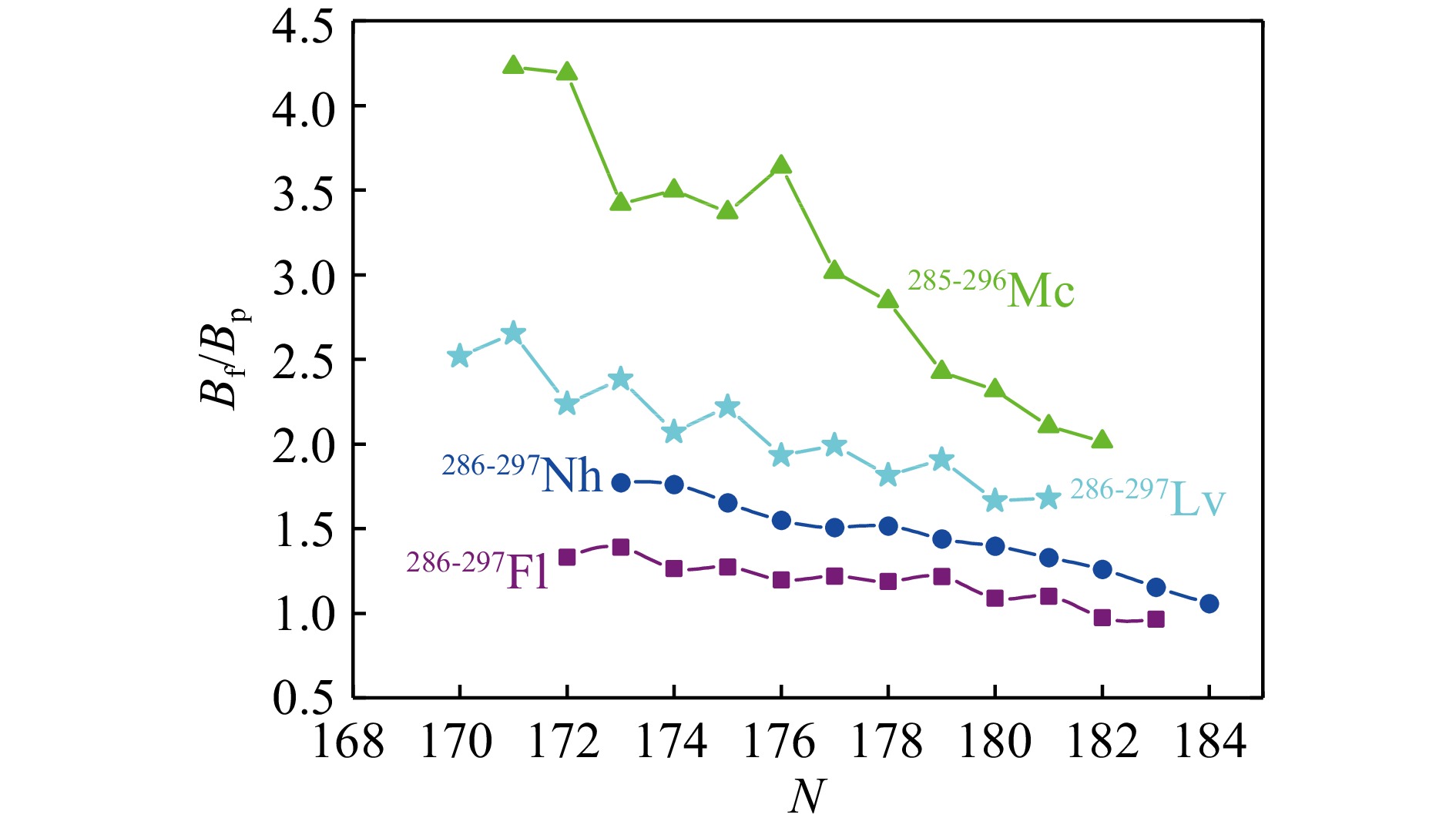
 甘公网安备 62010202000723号
甘公网安备 62010202000723号